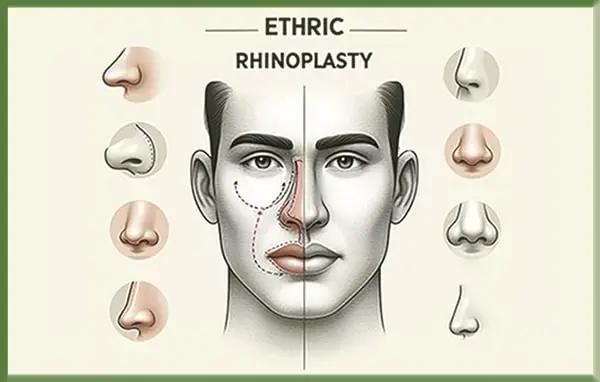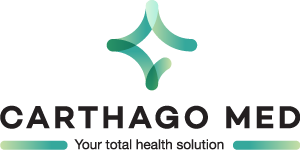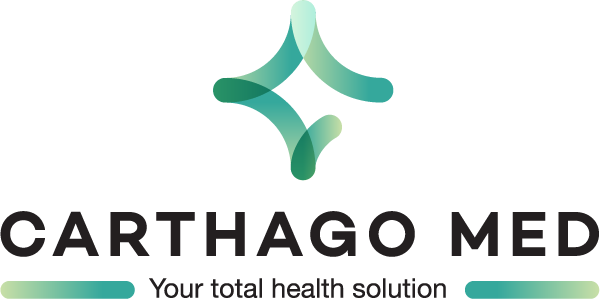
What about Ethnic Rhinoplasty ?
Ethnic rhinoplasty is a specific cosmetic procedure that can surgically alter the nose, which has no Caucasian features. It is usually designed for Africans, Indians, Asians, Arabs, etc. The goal of the procedure is to refine the genetically predetermined shape, which often results in insufficient development of bone and cartilage structures but without altering the ethnic characteristics of the patient. This is only possible through surgery.
WHAT ARE THE PROCEDURES FOR ETHNIC RHINOPLASTY?
Usually, a nose is called ethnic when nasal bones have a broad and flattened appearance with wide nostrils and an amazed nose tip. There are two (2) varieties of ethnic noses: African nose and Asian nose. African descents tend to refine the nose as a whole and reduce the size of the nostrils, while Asian people would rather raise the nasal bridge and decrease the size of nasal wing. An Ethnic rhinoplasty is usually characterized by a thick skin, a weak cartilage and bones that are rather short. Skin thickness associated with the usual presence of a greasy compartment and the lack of support on the other side of the nose, either the back or the tip and the base of the nose, is rather characterized by a rhinoplasty of structural augmentation. It aims to reduce the proportions of the nose seen from the front and to increase the profile proportions.
Sculpting the perfect nose involves a variety of techniques, each addressing unique aesthetic concerns. For individuals with thicker skin, basal implant placement offers a tailored solution. This procedure strategically inserts implants to correct the nasal structure, often employed to elevate the bridge and tip, particularly when addressing concerns prevalent in Asian noses. Cartilage grafts, commonly harvested from the ear, lend valuable support and definition. They can be used to project the tip, bolster a sunken bridge, or fill in irregularities along the nose's edge. This adds subtle yet impactful enhancements.
When excess skin and wider nostrils detract from facial harmony, nasal plasty steps in. This technique meticulously removes redundant tissue, resulting in a more refined profile. The discreet scar resides within a natural fold, minimizing its visibility. For noses with prominent tips, suture cartilage offers a precise solution. This technique employs stitches to strategically reshape the cartilage, resulting in a sharper, more delicate contour.
Lastly, bone and cartilage resection osteotomy tackles the bony foundation of the nose. This meticulous procedure refines the bridge's bony base and strategically adjusts the tip position, creating a more sculpted and balanced profile. By understanding these specific techniques and their strengths, individuals can embark on a personalized journey towards their desired nasal aesthetic. Remember, consulting a qualified facial plastic surgeon is crucial for ensuring a safe and successful outcome.
WHAT HAPPENS AFTER PROCEDURE?
Once back at home or in a hotel room, patients should get a lot of rest and lay in bed with their heads raised higher than their chests to minimize swelling. Positioning a cold compress or ice pack carefully over the nasal packing can lessen some discomfort. A cotton gauze dressing is taped under the nose to catch any blood or mucus. This dressing will likely have to be changed several times each day. It is very important not to blow the nose in the first week after the nasal packing has been removed. Dr. Bloch will advise patient when care can be resumed. Patients need to call if a temperature of 101 or higher, dizziness, severe bleeding, blurred vision, face becomes increasingly red and swollen, or decreasing urine color is observed. The first follow-up visit should typically take place in 2-3 days. On that day the packing material from the nose is removed. Swelling and bruising, especially around eyes, will reach a peak around the third day of recovery and then will gradually subside. It may take a few days before patients can return to their normal routines and activities. For the first 48 hours, patients should avoid bending, lifting or engaging in strenuous activities. Patients should also avoid smiling or laughing, which can cause movement of the upper lip and place tension on the incision position. Work and social activities can be resumed in 1-2 weeks, as desired, but patients should avoid engaging in any contact sports or strenuous exercise until released to do so by the physician. Full recovery from a rhinoplasty procedure can take up to 2-3 months. Although most of the obvious swelling will fade in a few weeks, it may take many months for the swelling to fully dissipate and a true representation of result to be visible.

What are the most important factors to consider when choosing a rhinoplasty surgeon?
When considering altering your body through surgery, it is important to remember that any surgery is serious and should not be taken lightly. When it comes to rhinoplasty, where the nose will be reconstructed and reshaped, choosing the best rhinoplasty surgeon really is a critical part of the process. This selection will help to ensure that you have selected a surgeon who has enough experience in the type of surgery that you require. This means that you will get better results and you will reduce or eliminate the risks associated with the surgery. To help you to determine the best rhinoplasty surgeon, you need to consider many different factors including the surgeon’s skills and experience, the type of facility in which they practice and the type of support and after-care that is given by the surgeon.
Frequently Asked Questions
Am I a candidate for ethnic rhinoplasty?
There are two major issues to address before determining if a patient is a candidate for ethnic rhinoplasty. The first issue is medical in nature. Every patient interested in undergoing ethnic rhinoplasty must pass a basic check-up. Since this is a surgical procedure, it must be ensured that the patient is in good health. If the doctor finds any condition that may interfere with the surgery, that condition needs to be treated first. Most of the time, candidates for ethnic rhinoplasty are healthy individuals. Students are sometimes caught between waiting during long breaks to get the surgery done, or proceed ahead and ask time off from school. This is a personal decision; however, I have found it optimal for students to consider getting the surgery done during summer/spring break. By doing so, they avoid taking time off from their academic studies. The second issue to consider when determining if a patient is a candidate for ethnic rhinoplasty is the patient’s expectations. It is normal for individuals to have certain expectations for the surgery and resulting image. However, it’s important to manage those expectations. This is because while ethnic rhinoplasty can contribute to a patient’s goal of preserving their ethnic identity, every person’s body is different. There is no way to guarantee that someone’s ideal goals can be met. Also, each patient’s body is different and may react differently to the surgery. I encourage patients to be as detailed as possible when discussing their expectations. Visual aid can also be helpful. For example, some doctors will recommend computer imaging technology to help patients express their expectations better. With this technology, a patient’s portrait can be transferred into a computer, and through a program, that image can be altered to represent potential results of the surgery. This way, both the doctor and patient have a better understanding of the patient’s ideal goal and what’s realistically possible to achieve.
Can ethnic rhinoplasty repair a previous rhinoplasty?
When a patient is not satisfied with the results of a previous rhinoplasty, this can be a very emotional experience. Revision rhinoplasty procedures are always more complex, no matter what type of rhinoplasty was performed previously. The part of the nose that is worked on in a revision rhinoplasty has almost always been operated on before. The nose has scar tissue deep to the skin which forms after rhinoplasty and this can make the dissection of the soft tissues in revision rhinoplasty more difficult. If the previous operative notes and details of what was done during the primary rhinoplasty are available to the surgeon, this can be helpful in planning the revision surgery. If one is unhappy with the cosmetic result of a previous rhinoplasty then this can similarly have a powerful effect on a person's self confidence. It's even more difficult when the original surgery has been performed for ethnic reasons - perhaps the original rhinoplasty hasn't been entirely effective in reducing a wide bridge of the nose, or in altering the appearance of the nose tip. Patients might be wary about undergoing further surgery due to their first negative experience. Specialist ethnic rhinoplasty surgeons understand that revision ethnic rhinoplasty is a highly complex procedure and an extremely delicate operation.
Do I need to stop smoking before the surgery?
Yes, you absolutely must stop smoking before rhinoplasty and keep away from any form of nicotine throughout the entire healing process. The ingredients in tobacco smoke are toxic and restrict the flow of oxygen and nutrients in the blood. By smoking in the weeks and days leading up to your operation, you're slowing down your body's natural ability to heal itself. This puts you at a higher risk of inflammation, infection, and serious healing problems in the days and weeks after your operation. For information about nose job London it is recommended approaching a professional. Also, if you use e-cigarettes, nicotine patches, and nicotine gum, it is the same story. These products will also restrict the flow of oxygen and can lead to serious complications post-op. For your best chances of recovery and a good outcome, it is recommended to stop smoking eight weeks before surgery. This can be difficult, but your surgeon, GP, or a local NHS service can provide advice and resources to help you quit.
Can ethnic rhinoplasty fix a deviated septum?
The septum is a wall that divides the two nostrils. If it becomes displaced or crooked this can result in reduced airflow in the nasal passages and lead to regular nosebleeds. This is known as a deviated septum and it requires a surgical procedure called a septoplasty to fix. A septoplasty involves moving the septum into the correct position and this process is unrelated to the changes made during rhinoplasty. However, it is common for patients to also elect to have a rhinoplasty at the same time, to change the shape of their nose to better suit their face. This procedure is known as a septo-rhinoplasty. In a septo-rhinoplasty operation, the surgeon will first make incisions internally within the nose and then lift up the soft tissue. This allows them to access the cartilage and the bone, which can then be strategically removed, reshaped or augmented. The surgeon needs to be especially careful if the patient is also suffering from a deviated septum so as to avoid making the correction any more difficult. Ethnic rhinoplasty can indeed fix a deviated septum, will be corrected as part of the procedure.









